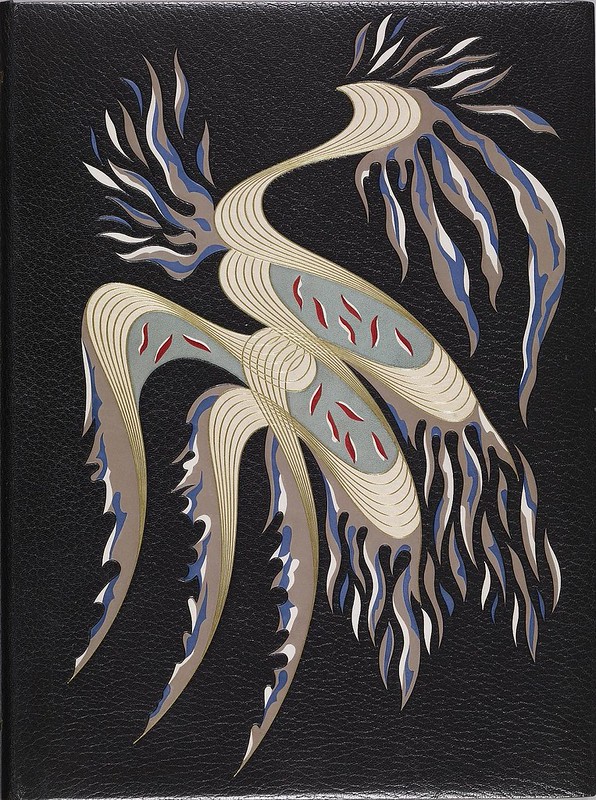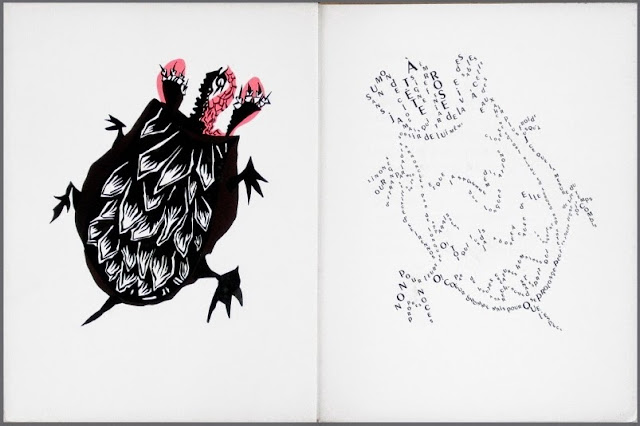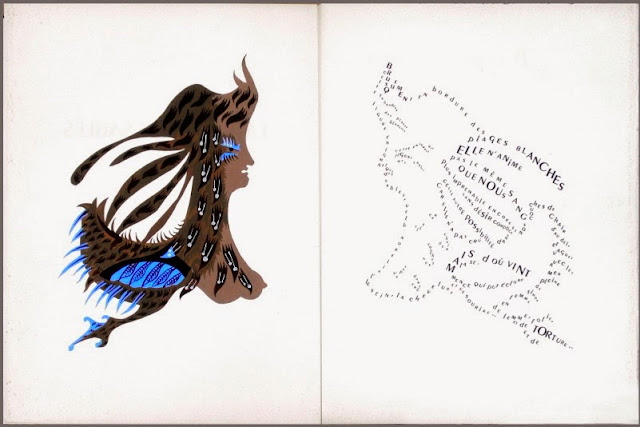A mid-20th century collaboration between artists, poets and printers gave rise to a unique book of surrealistic creatures accompanied by complementary typographic art poems.
The original gouache designs of fabulous beasts were produced by Jean Lurçat, which inspired poems by Patrice de la Tour du Pin. The sketches were rendered as lithographs by Vairel Edmond and the poems were turned into calligrams* by Jules-Dominique Morniroli. The book was printed/published in a limited edition by Maurice Darantiere at P. Gaudin in 1948.
At least a couple of the participants in this project became friends while working for the French underground during World War 2.
"A calligram is a poem, phrase, or word in which the typeface, calligraphy or handwriting is arranged in a way that creates a visual image."Previously: Zoomorphic Calligraphy || Hebrew Micrography.
ADDIT: Poem transcription/translation by Rolland B:
Araignée mangeuse de reflets danseurs
Araignée cinéraire d’étoiles que nous saurons éteindre
afin que notre ciel s’étende comme un suaire de toute vie
A l’infini tisseuse de constellations mortes
sur les fosses passées et peut-être à venir
de l’étroit fleuve à vivre, lumineuse
pour je ne sais quelle cause
Probablement folle, elle tend ses filets
aux mailles si fragiles que le rêve d’un rêve
ne devrait pas s ‘y laisser prendre.
Spider, eater of dancing glimmers,
burial urn for the stars we will manage to extinguish
intending to make our skies into a shroud for anything once living,
infinitely weaving dead constellations
over past and perhaps future graves
in the narrow river of life,
glowing for some unknown reason,
probably insane, thou keeps weaving thy nets
so frail their links, the dream of a dream
could not be caught in them.

"This book of poems with accompanying gouaches (opaque watercolors) and calligrams (figures made up of letters) about fantastic beasts and imaginary animals was bound by Thérèse Moncey. It features an abstract, birdlike form designed by the binder and won the French Grand Prix for Bookbinding in 1950." [source] The binding was made from calfskin, goatskin, and gold.
ADDIT: Translation kindly supplied by Alcebiades DM:
He is the one lurking around
From the pre-Human night
Where we go
the Heart unquietness,
sometimes the Mind,
often the Dream,
And lead to the suffocating
thick vases
The invitation to pure beauty,
and the promise
That all life can discover
his musical note...
Without him, relinking
the blind fauna of deep shadows
Indistinguishable to our eyes
made to the Sun,
With the Matters of Joy?
Without Orpheus
And his crystal seed,
The blood will choke us all…
ADDIT: Translation/Transcription kindly supplied by Rolland B:
{I may get around to polishing the English, which is not Rolland's primary language}
Le serpent qui jadis donna son rythme au monde,
serpent épousant toutes les vagues du temps
dessinant les questions en s’enlaçant lui-même
(illisible) les paradis
Quand il prit leur couleur aux quatre fleuves,
son sifflement aux trilles du sang dans les oreilles,
c’est donc de lui que nous renaquîmes
et même sur les dunes silencieuses de la pensée, passer sans nom;
J’entends cette promesse de vivre par mon absence.
The Serpent long ago gave its rhythm to the world,
serpent following the waves of Time
shaping the Questions by coiling round itself,
( one word illegible) the Paradises,
As it borrowed its colors from the Four Rivers,
and its hissing from the humming of the blood in the ears
Thus, from it we are born again.
Even on the silent dunes of Thought, it slides without a name.
Even as I am absent, I can hear this promise of life,
"Jean Lurçat (1892-1966) was a French Expressionist/Surrealist artist born in Vosges. He was exposed to art as a young boy when his parents introduced him to the founder of the Ecole Nancy, Victor Prouve. He traveled to Paris when he was 20, enrolling at the Ecole des Beaux-Arts and then the Academie Colarossi. Throughout his career, Lurçat would form a style of his own, derived from his travels through the Mediterranean, North Africa and the Middle East. His unique style had a primitive, native art feel and was composed of symbols and hieroglyphic-like imagery. Within this style, he created ceramics, paintings, tapestry and a number of other art pieces.
It was in fact Lurçat's tapestry creations that brought him the most attention, and he is even often credited with bringing this age old art form back into fashion. He has been called the leading tapestry designer of the 20th century, and worked for the Aubusson factory creating his textile designs. During his lifetime, Lurçat also traveled to Spain and the Sahara where he was influenced to paint a number of Surrealist landscapes. He was only briefly associated with the Surrealist movement, as he experimented often with Expressionism and tribal art." [source]
"Patrice de La Tour du Pin (1911–1975) was a major French, Catholic poet of the mid-twentieth century. As a poet, he achieved fame for individual collections of poems as well as Une Somme de poésie, a three-volume multi-genred work he wrote and continually revised throughout his life. Late in his career, de La Tour du Pin distilled and collected his most powerful lyrical poems, written in the form of psalms, into Psaumes de tous mes temps. These psalms trace de La Tour du Pin’s combined interest in poetry and religion and articulate his struggle to find poetic authority and spiritual meaning in the midst of world war and modern tumult." [source]
'Le Bestiaire Fabuleux' consists of 14 lithographs of Lurçat's abstracted figures, the majority (but not all!) of which have been posted above. To see any omissions, you will have to visit the source site. The images were uploaded in 2011 in celebration of the 100th anniversary of Patrice de la Tour du Pin's birth. It's a shame the images are only of a modest size, though the fabulous surreal animals mirrored by poetic calligrams make this book too unique a work to pass up for so minor a detraction. I saw no commentary about the poems' content and I decided to skip the opportunity to embarrass (like that would have been the first time) myself with poor-to-partial translation guesses. If anyone can work out the gist or full meaning of the calligrams, please leave a comment or send me an email (gmail peacay).
- Jean Lurçat at Wikipedia.
- An extensive chronology/biography of Lurçat.
- BBC bio of Lurçat.
- 'Chouette de Bonne Esperance' at the V&A (owl).
- Qui est Jean Lurçat?
- Whitford Fine Art has a small bio and solo exhibition chronology.
- AbeBooks listing of Lurçat's bestiary for >£700.
- Books by or about Lurçat at Amazon.
- Bridgeman Art Library has quite a good sampling of Lurçat works.
- Jean Lurçat: “Bestiaire Corail”.
- French cemetery site has a few pictures; Lurçat has a grave marking of an artist.
- Patrice de la Tour du Pin at Wikipedia.Fr.
- This post first appeared on the BibliOdyssey website.




























No comments :
Post a Comment
Comments are all moderated so don't waste your time spamming: they will never show up.
If you include ANY links that aren't pertinent to the blog post or discussion they will be deleted and a rash will break out in your underwear.
Also: please play the ball and not the person.
Note: only a member of this blog may post a comment.